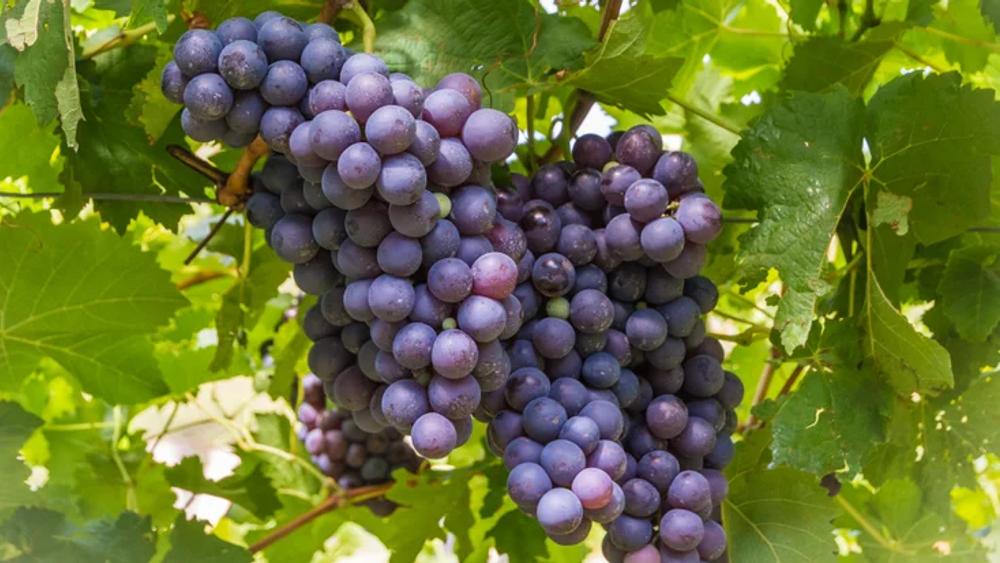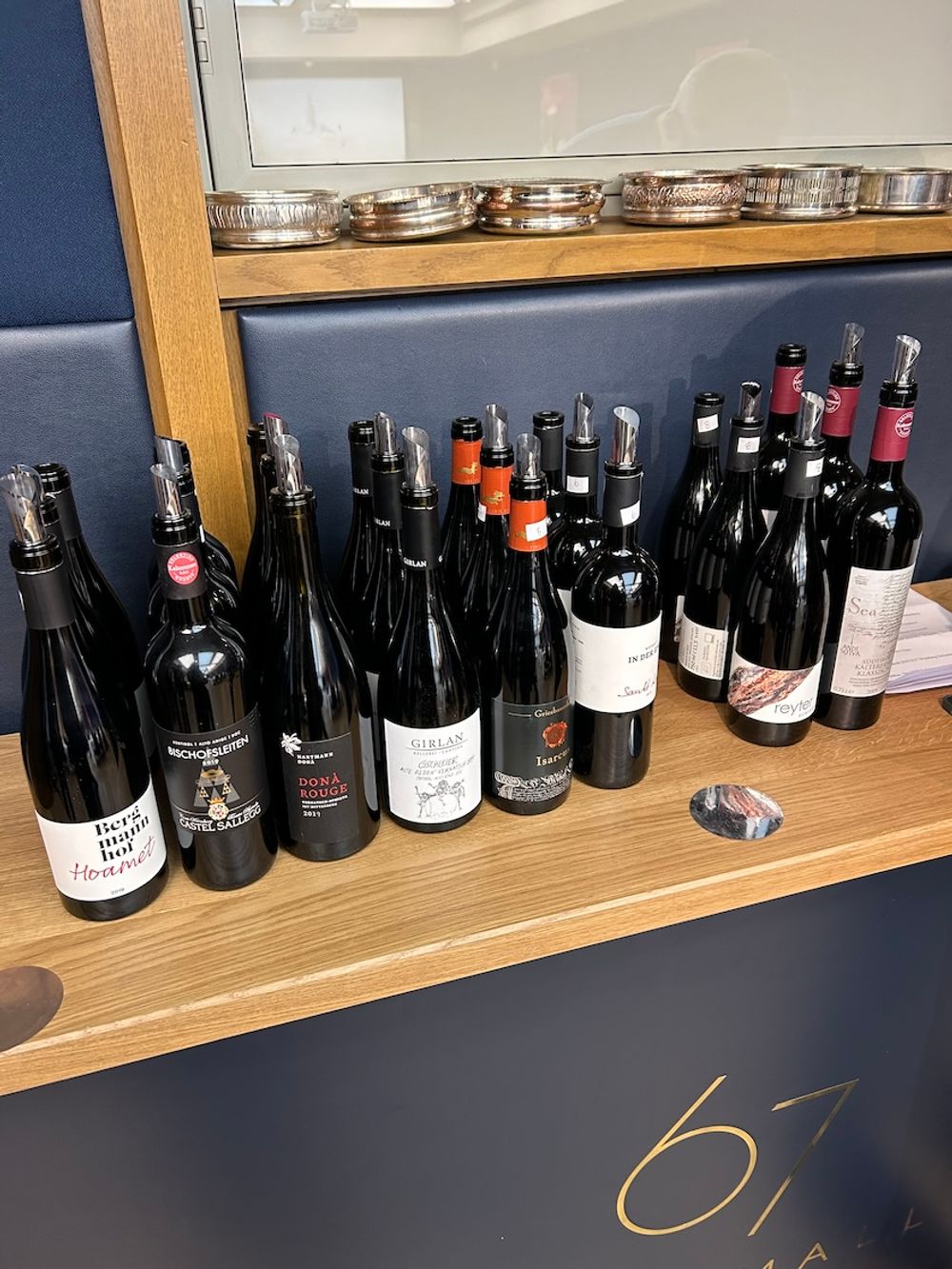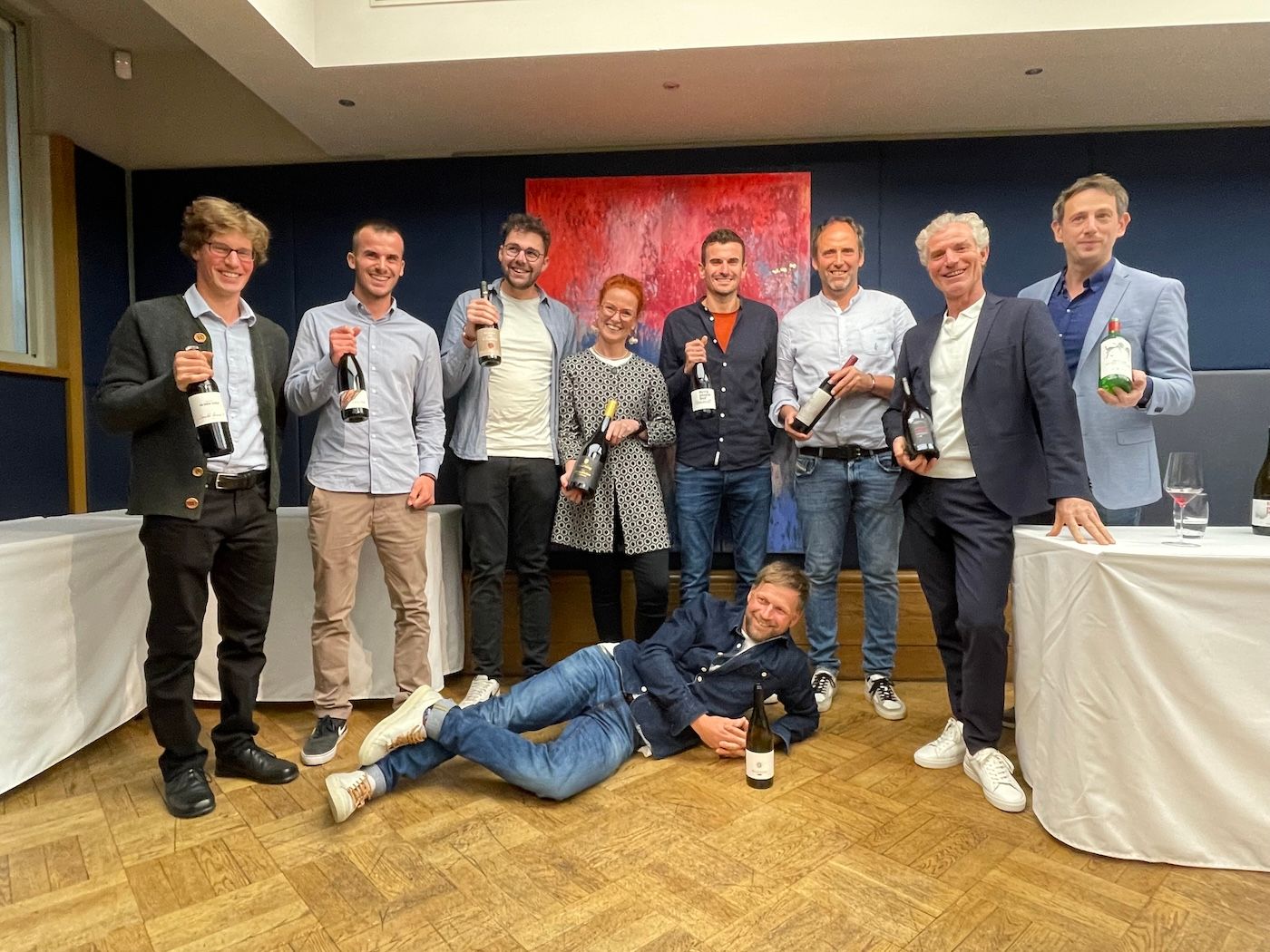In 2023, Italy was ranked as the world's second-largest wine producer, trailing behind France with 43.9 million hectoliters*, a decrease from its first-place position of 50 million hl in 2022**. Whilst being one of the world’s largest wine producers is an excellent position to occupy, it also raises problems and ongoing debates, with some questioning quality over quantity. With that in mind, let’s take a trip to this amazingly colourful wine country, and zoom in on Alto Adige.
Set in the Alpine region of North Italy, this is a picturesque region with a wide range of terroirs. Factors like the rain shadow and sheltering mountains, plus over 300 hours of sunshine means that Bolzano is often warmer in the summers than Sicily, although this is balanced by the cooling influences of Lake Garda and elevations up to 1000m above sea level. An abundant array of soils due to the intersection of African and European tectonic plates, also allows vines and their talented winemakers to thrive.
In this unique and ideal vine-growing environment, particularly in the southern valley of Alto Adige, ancient grape varieties ripen.

Vernatsch vineyard in the Trentino-South Tyrol region of Italy
Putting Vernatsch into context
Although Vernatsch (formerly known as Schiava) is a variety often overshadowed by its more illustrious counterparts like Piedmont's Nebbiolo, it fully deserves your attention – possessing a juicy, elegant, fragile, fruit-driven profile with a linear, age-worthy structure.
Geographically intertwined with the Alpine region of South Tyrol, Vernatsch boasts a rich historical legacy, dating back to the Roman conquest of Bolzano in northern Italy, where a winemaking culture had already flourished for at least 500 years. Presumed to have been cultivated during this time (although it could be earlier), Vernatsch derives its name from the Latin vernaculus, meaning "native."
Notably, its former name, Schiava, translates to "slave," referring to the pergola training system on which most vines were originally grown – the pergola system is particularly beneficial for this variety, helping to tame its vigour, hence the name “slave”. Three main biotypes of Schiava are grown in Alto Adige: Schiava Grossa, Schiava Gentile, and Schiava Grigia.
Initially prized for its production of light, quaffable wines Schiava used to be Swiss wine drinkers’ favourite back in the 1970s. Schiava has since suffered a decline in reputation, and plantings, due to shifting market demands, including the rise of other varieties like Pinot Grigio. A dramatic decline from 3,572 ha in 1973, total plantings of Schiava tumbled to just 635 ha by 2019 and further to 467 ha since. Since the 1980s there has been a local trend to replace the variety with mostly white varieties, reflecting the region's suitability for white wines from both climatic and marketing perspectives.
But fear not! A few committed, brave and talented winemakers of the current generation are breathing new life into this worthy variety. Since Schiava is so irretrievably associated with mediocrity – and locally it is usually referred to as Vernatsch – these innovative producers are calling for a name change. They are reclaiming ancient vineyards, embracing traditional methods, and experimenting with innovative techniques to showcase Vernatsch's potential for elegance, lower alcohol, complexity, and age-worthiness. The wines oftenexhibit aromas of red fruits, floral notes, toasted almonds, with a fresh and sometimes lightly spicy palate, bright acidity and a savoury finish.

Vernatsch aka Schiava
The new old Vernatsch: challenges and opportunities
Today, producers of Vernatsch are undergoing a transformative shift in vinification practices.
Unlike the past emphasis on quantity over quality, today's winemakers are prioritising meticulous vineyard management, low yields, and careful selection of clones to enhance grape quality. There's a significant change in winemaking practices towards embracing tannins and allowing longer skin contact for Vernatsch wines.
In the cellar, there's a renewed focus on extracting ripe tannins through longer skin contact, resulting in wines with greater structure and ageing potential. Many producers are also experimenting with extended ageing in cask to further develop complexity and depth. This departure from previous winemaking norms reflects a commitment to elevating Vernatsch to its rightful place.
Climate change poses both challenges and opportunities for Vernatsch production. Rising temperatures and shifting weather patterns in the Alpine region are affecting vineyard dynamics, including grape ripening, disease pressure, and water availability. While warmer conditions may extend the growing season and enhance ripeness, they also increase the risk of extreme weather events and pest infestations.
Additionally, changing precipitation patterns may necessitate adjustments in vineyard management practices, such as irrigation and canopy management, to mitigate the impacts of water stress or drought. The traditional pergola vine training seems to be preferred as there is less sunburn on the grapes – and its growers!
Legislative burdens – IGT or Single Vineyard?
During the London tasting it was interesting to discover that some of the wines exhibiting remarkable complexity were labelled as IGT Mitterberg (see a lovely example of it in the tasting notes). This observation underscores the reality that, in the world of winemaking, legislative frameworks can present both opportunities and challenges.
Despite their originality and exceptional quality, these wines often fall short of meeting the rigid criteria set by the DOC system, which refuses the certification because they are considered a-typical and therefore are rejected as ‘faulty’.
Therefore regardless of whether a wine is a single vineyard or not, producers are often restricted to labelling it as an IGT. This can skew perceptions, as one might purchase an IGT Mitterberg wine without realising it could well be from a single vineyard.
However, despite the regulatory hurdles they faced, these wines unquestionably shine as some of the region's finest expressions and its great to see that producers are still making them, flying the flag for the variety.
A deeper understanding of Vernatsch's terroir expression, coupled with innovative viticultural and winemaking techniques, positions this handful of producers to adapt and thrive in the face of fashion trends, and changes in legislation or climate. I remain hopeful that the continued excellence of Vernatsch wines will stay with us for generations to come.
The future and the reputation of Alto Adige's wines could depend on embracing these new approaches to Vernatsch.

The wines chosen to demonstrate the qualities of Vernatsch at the London tasting
Walter Speller’s selection of Vernatsch
Speller spent 13 years as a sommelier in Berlin. He then moved to London in 2003, where he worked as a sommelier, wine buyer, and export consultant. Since 2008, he has been the Italian specialist (now Editor Italy) at www.JancisRobinson.com, offering insights into Italian wine with a focus on cultural, historical, and socio-economic aspects. Walter is also a contributing editor to the World Atlas of Wine and The Oxford Companion of Wine. Passionate about preserving rare local grapes and denominations, he is an organiser of generic Italian trade events like Nebbiolo Day and Sangiovese RESET with Jane Hunt MW.
At a revelational tasting organised by him at 67 Pall Mall in April nine new generation Vernatsch winemakers presented their wines with one objective – to revive interest in the variety, focusing on its individual expressions that can age for over a decade.
Pranzegg winery is nestled on a north-east-facing slope overlooking the prestigious Santa Maddalena vineyards in Alto Adige. In 2000, Martin Gojer inherited the family estate, embarking on a journey to make wines that honour the region's indigenous varieties. Despite initially planting international grape varieties like Chardonnay and Sauvignon Blanc, Gojer soon realised there was unmatched complexity found in local varieties. Embracing an holistic approach to winemaking, Pranzegg focuses on biodynamic practices and minimal intervention in the cellar. The top of its wine portfolio is the Campill, crafted from old-vine Vernatsch grapes.
Pranzegg, Campill 2019 Vino
This wine comes from a 40-to 50-year-old pergola-trained, biodynamically managed vineyard on a steep slope in the Campill cru; fermented spontaneously and aged in oval casks and concrete.
Cherry blossom nose, kind and inviting. Oozing in freshness. Zingy, linear acidity all in perfect harmony with red, raspberry and cherry fruit and structure. Coating tannins and refreshing, juicy length. So bright!
Hartmann Donà, inheriting a family tradition of cultivating Schiava, was inspired by his uncle oenologist Giorgio Crai, a key figure in preserving Vernatsch's quality. Donà is dedicated to reviving the grape's prestige.
Donà’s focus is on single-vineyard Vernatsch from diverse soils like Phyllit, Dolomit, and Granit, to highlight the complexity of the region. His wines are classified under IGT Mitterberg. Annual production of 35,000 to 40,000 bottles with a commitment to minimal intervention and low yields. Donà's flagship Donà Rouge, first released in 2001, marked the beginning of his two-decade journey to redefine Vernatsch's image. Looking for UK importer
Hartmann Donà - Donà Rouge Vernatsch 2019 IGT Mitterberg
Bright mid-ruby, with an intriguing bouquet reminiscent of the Alto Adige countryside, dark red fruit, with subtle hints of peppermint and liquorice. Displays a structured profile with noticeable grip and a linear quality. The palate reveals layers of flavour, contributing to its overall elegance.
Hartmann Donà - Donà Rouge Vernatsch 2011 IGT Mitterberg
23 months in wooden barrels followed by two years of bottle ageing. Rooted in graphite soils.
Shockingly bright and vivid ruby colour for its age. Spicy yet soft nose. Tertiary notes of vanilla and dried cherries hinting at its age while preserving ample fruitiness, strawberries and raspberries. Heralds complexity. Depth, clarity, balance and focus define its palate, offering a wide spectrum of flavours complemented by elegant, refined tannins and length.
Located along the picturesque South Tyrolean Wine Route in Eppan, Bergmannhof has been under the stewardship of the Pichler family since 1851. With roots dating back to the 17th century, the estate embodies a rich legacy of winemaking. Led by three generations of passionate vintners—Karl, Josef, and Johannes Pichler—the family's commitment to quality is unwavering. Since 1978, when Karl and Josef embarked on the journey of processing their vineyard's grapes, the estate has flourished. The Pichler family tends to their 2.5-hectare vineyard by hand, with a dedication to traditional methods and sustainable practices. Looking for UK importer
Bergmannhof, Hoamet 2019 IGT Mitterberg
A pleasant combination of red cherries, umami notes, and a subtle hint of spice. Its silky tannins contribute to a smooth texture, making it easy to drink while still providing depth. Freshness and balance characterise its profile, with a juicy quality that adds to its appeal. Overall, it presents an elegant and well-rounded drinking experience.
Girlan winery, established in 1923, founded by 24 vine-growers in a 16th-century farmstead, now encompasses 200 dedicated families farming 230 hectares of vineyards across Oltradige and Bassa Atesina. Enologist Gerhard Kofler collaborates closely with the growers to ensure the production of high-quality wines.
Its historic vineyard, Gschleier, produces exceptional Vernatsch wines with elegance, complexity, and minerality, challenging misconceptions about pergola training and vine density. Despite the variety’s challenges, the winery remains committed to showcasing the potential of Vernatsch, exemplified by quality and great value.
Girlan, Gschleier Alte Reben Vernatsch 2019 Südtirol
A vibrant cranberry hue and layered aromas of red fruit. Elegance and finesse on the palate, with structured notes of ripe red berries and subtle spice. Impressive length and balance, reflecting the meticulous care given to the old-vine fruit. Characterful and charming, enjoyment for many years to come.
Located in Cardano, since 1982. The Plattner family has nurtured three hectares of vineyards with dedication, transitioning to biodynamic practices under the guidance of Johannes Plattner. His son Urban has been continuing this legacy since 2011. One of the first estate wineries to have been operated organically. With a commitment to ‘living wines’ and biodynamic cultivation since 2014. Looking for UK importer
In Der Eben, St Anna Vernatsch 2019 IGT Weinberg Dolomiten
Made with 60% whole bunches, aged in large oak casks. Ripe and vibrant, reminiscent of the elegance found in Barolo but with a lighter touch. The nose offers intriguing hints of frankincense, followed by the allure of ripe strawberries and raspberries. On the palate, it reveals a delightful interplay of spice, with a touch of edginess complemented by notes of chocolate and truffle. Structured and balanced, it maintains a focused drive throughout.
Established in Caldaro, Alto Adige, Castel Sallegg has maintained a family tradition in winemaking since 1851 under the Counts of Kuenburg. Across generations, the estate has remained under family ownership, becoming synonymous with tradition and responsibility. Nestled around Lake Caldaro, the vineyards enjoy a diverse climate influenced by both Mediterranean and Alpine conditions, with altitudes spanning from 230 to 550 metres above sea level. This varied climate landscape facilitates the cultivation of a wide range of grape varieties, each tailored to its particular microclimate.
Castel Sallegg, Vigna Bischofsleiten 2019 Kalterersee Klassisch Superiore
Gentle and inviting nose with rosehip and lots of charm. Crunchy, fresh cherry and hint of sweet spice and almond. Subtle structure, light but firm (like a ballet dancer) with great depth, a fine length and well-integrated tannins.

Tasting through the Vernatsch wines shown at the London tasting
Established in 1996 in Bozen, South Tyrol, this estate has embraced organic farming practices, with a transition to biodynamic methods in 2014. This commitment to ecological and biodynamic principles extends to its vineyards, where herbs and grains coexist with the vines, adding to the unique character of the wines. Noteworthy are its well over hundred-year-old pergolas in Kaltern and Tramin, hosting Vernatsch vines dating back to 1920 and 1950, nurtured by Christoph Unterhofer. Looking for UK importer
Reyter, Vernatsch 2019 IGT Weinberg Dolomiten
Grapes come from vineyards in Caldaro and Termeno. Spontaneous fermentation in stainless steel, followed by MLF and ageing for 18 months in 500-litre tonneaux.
Rubbery, animal, with black olives and thyme on the nose. Savoury, focused, deep raspberry fruit, herbs, and tobacco. Lively acidity framed with powdery, ripe tannins and a mineral finish.
Andi Sölva
Andi Sölva took over his parents' vineyards in 2005, transitioning to crafting his own wines in 2007. As an advocate for individuality, his focus is on capturing the distinctiveness and variety of the Lake Kaltern region in his wines. Operating on a smaller scale, Sölva personally oversees much of the vineyard work, from monitoring growth to hand-selecting ripe grapes, resulting in an annual yield of approximately 8,000 bottles. The vineyards boast old vines nearly a century old, thriving in diverse soil types ranging from deep lime and gravel to sand, clay, and volcanic elements, situated between 215 to 500 metres above sea level. The afternoon Lake Garda wind, known as the 'Ora,' further contributes to the unique terroir here. Looking for UK importer.
Andi Sölva, Sea 2016 Kalterersee Klassisch
Cherries and almonds dance alongside notes of graphite, oozing red fruit, and depth, while a hint of rosehip adds a delightful twist. On the palate, it offers a velvety texture and fine coating tannins, leading to a balanced and nuanced length that lingers gracefully on the palate.
Located on the foothills of St. Magdalena (one of Schiava’s traditional strongholds) and St. Justina in the suburb of Rentsch in Bozen, Griesbauerhof winery has been a part of the Mumelter family's history since 1785. Georg Mumelter, the current steward, sees preserving this tradition as a vital duty. The winery operates at 300 metres above sea level, where tradition and expertise guide every step, from vineyard management to bottling and ageing in the cellar. Notably, the winery produces Isarcus, a wine crafted using partially pruned vine branches to allow grapes to wither, making the timing of cutting and harvesting crucial.
Griesbauerhof, Isarcus 2019 St Magdalener Klassisch
Radiant ruby red in colour, this wine has the essence of strawberry jam. Amarone-like. Crafted using partially pruned vine branches to allow grapes to wither and concentrate sugar and alcohol due to a later harvest.
On the palate, intense cherry aromas and almond notes mingle with ripe fruit flavours and a fine, fresh acidity. Plums, baked ripe cherries with a touch of cinnamon. Structured and it offers a sweet fruit core with a long, satisfying finish.
* IOV 2023 Wine Production, First Estimates
**Wine production worldwide in 2022, by country, Statista.com
































